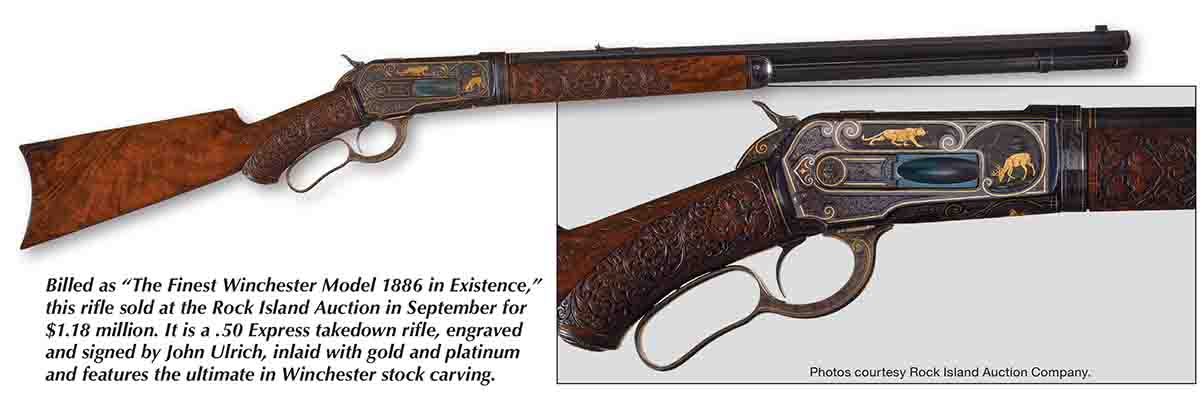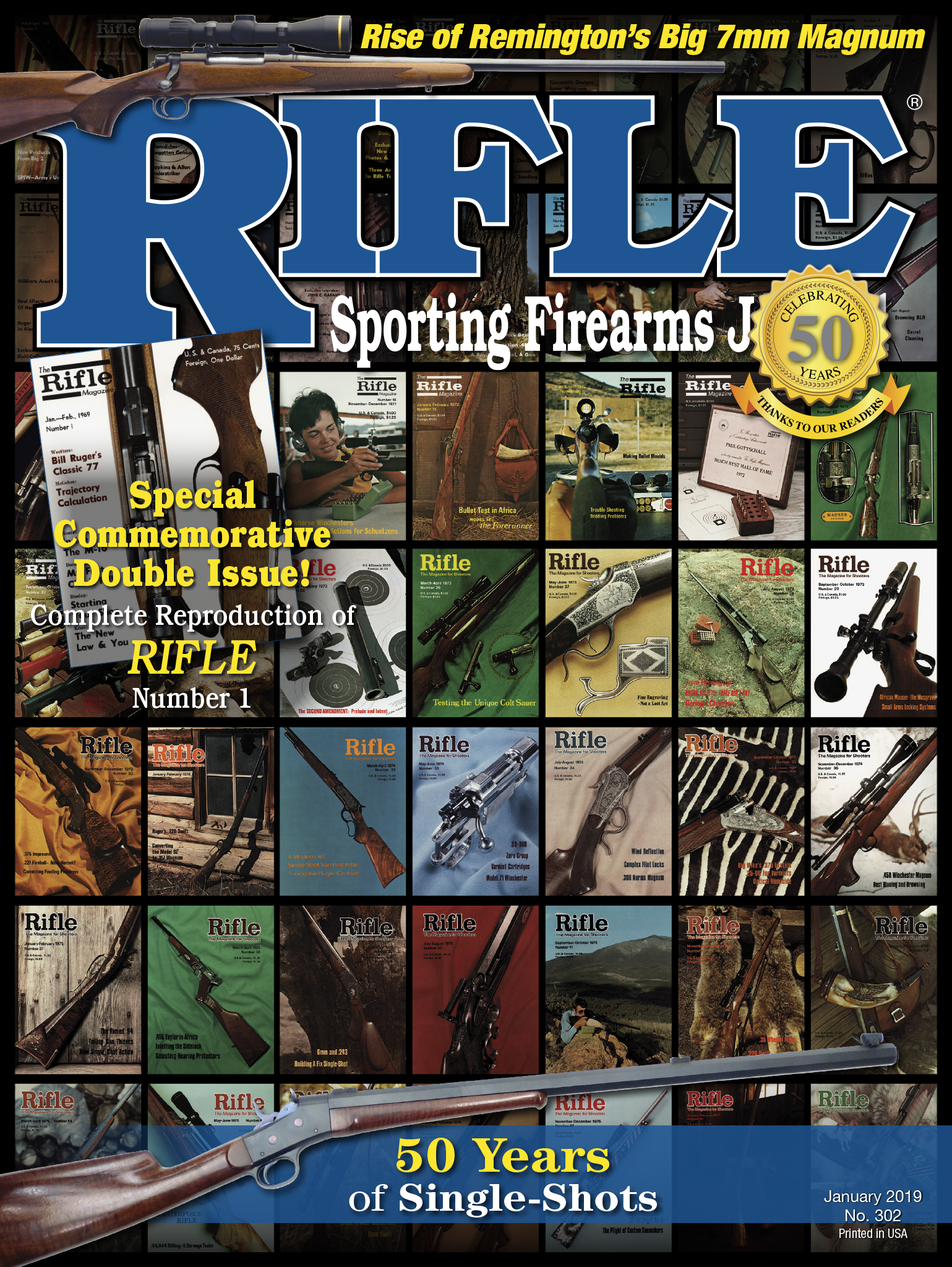Walnut Hill
Rock Island Auction
column By: Terry Wieland | January, 19

Since that is everyone’s immediate question, here is the immediate answer: At the Rock Island Auction in September 2018, the prize was a Winchester Model 1886 billed as “The Finest ’86 in Existence.” On the first morning of the three-day event, it sold for a cool $1.18 million. I won’t attempt to describe it; the accompanying photos give you an idea of what this treasure looks like.
That price set a high standard, but another Winchester, a Model 1876 “One of One Thousand,” sold on day two for $891,250. Altogether, approximately 3,000 guns and related artifacts sold over three days, bringing in a total of more than $20 million. That, according to Rock Island, is not only its largest gross ever, but it was also the largest gun auction in history in terms of dollars; not bad for a company that only began operation in 1995 and was taking on such established names in the world of big-money gun sales as Sotheby’s.
Today the Rock Island Auction Company (RIAC) occupies its own compound of buildings in Rock Island, Illinois, and has about 90 full-time employees. These buildings include a large auction hall fitted with closed-circuit television, seating for several hundred people and a bank of two dozen telephones and computer terminals. There is a warehouse for storing guns as they come in on consignment. The company employs a team of evaluators, and it has a vast reference library and facilities for photographing guns to illustrate an elaborate full-color catalog that runs to three volumes and 900 pages. The catalog, which costs $85, is as beautifully laid out as a fine book.
The company holds three “premier” auctions every year as well as regional and online auctions. Altogether they average about an auction a month at Rock Island, in one form or another.
The Rock Island Auction had been on my short list for a long time, and I set off in September for four days in Rock Island, Illinois, playground of incredible guns and big money. The auction takes place over three consecutive days and is preceded by one viewing day when all the guns are on display.
When the action begins on Friday morning, the portion of the showroom containing Friday’s items is closed, but you can still look at lots scheduled for Saturday and Sunday. On Saturday, only Sunday’s items can be viewed, and on Sunday you’re down to studying the catalog. This arrangement seems complicated, but it’s necessary to keep everything under control and moving smoothly as items are auctioned, bidders pay for purchases, collect them and leave.
Over the course of the auction, the showroom becomes the social center, and it’s no wonder. Where else can you see 3,000 guns on display, ranging from wheellocks to Garands, from flintlock dueling pistols to presentation 1911s, and not only get to look at them but handle them and study them up close?
No museum I know of will allow anyone to look at its displays that closely, and few gun shows include such a range of rare firearms of all types. At Rock Island, there are the advantages of a fine museum combined with a gun show where you can buy something you like (or try to, at least) and actually handle a treasure that you may never be able to afford but find fascinating nonetheless.
One thing I noticed about the Rock Island Auction is the range of knowledge of the people who attend. Rock Island, Illinois, is not particularly hard to get to, but it’s not easy, either. It requires effort. Hundreds of potential buyers made the trip, however, because it’s worth it just to see the guns for sale. Somewhere among the visitors there is surely a genuine expert on anything that takes your fancy. From a Walther PPK that belonged to Hermann Goering to a Flues-model Ithaca trap gun, someone will appear who has made it his life’s work.
At the risk of sounding like a chamber of commerce tourism director, the Rock Island Auction has made Rock Island, Illinois, into what is called a “destination.”
The company was founded in 1995 by Pat Hogan, who remains CEO. His son Kevin is company president and runs day-to-day operations. The elder Mr. Hogan still takes a prominent role, including his stints each day as auctioneer. At any one time there were three auctioneers on the podium spelling each other off every 20 or 30 items. The two who were not actively calling were spotting the bids from the phones, the floor or the Internet.
With a thousand items a day to auction, things move quickly. Out of curiosity, I timed one item. It took 14 seconds to sell from the time auctioneer Jessica Tanghe called “Here we go!” until she declared “Sold.” This was not an insubstantial item, either; it brought about $2,000 and had several active bidders.
The ring-bound catalog is divided into three volumes, one for each day, allowing you to keep it open and available for consultation throughout the auction. When the bidding is in progress, however, if the catalog is not open to the right page, there is simply no time. Instead of having an attendant parade the item that is up for auction, photos are shown on closed-circuit TVs placed throughout the room. The lot number shown under the photo on the TV is easy to reference in the catalog – if you have the time. Unless you are following along closely, however, you usually do not.
I went with the intention of bidding on one gun, a Webley “WG” military revolver sold to an English aristocrat by James Woodward & Sons of London. When it came up for sale I was ready, having studied the catalog and looked at the gun itself in the showroom. An attendant opened the case and handed me the gun, I looked it over carefully, he put it back, and I was later lucky enough to get it for exactly the price I hoped to pay.
That is the ideal vision of how a prudent buyer approaches an auction. Then there is the last-minute scramble of snap decisions and double doses of adrenalin. On day three, I was watching the auction when up popped an image of a classic Schutzen rifle, apparently original. It was a Stevens from around 1900, but that and the caliber (.25-20) were all I knew about it. There was no time to do anything except scan the TV screen, frantically looking for flaws. I could find none. The bidding stalled, I raised my card, another guy then out-bid me, I raised the card a second time, and the room went silent. Sold, to Bidder No. 512.
That was, without a doubt, the fastest $2,000 impulse buy I have ever made. But the rifle is a honey and, as I later found out, the description in the catalog undoubtedly discouraged some potential bidders. It said the rifle needed mechanical work, but that turned out not to be true. If I’d had time to consult the catalog, I probably would not have bid either. Instead, I had to rely on gut instinct and a snap decision, and for once it paid off. How’s that for luck?


